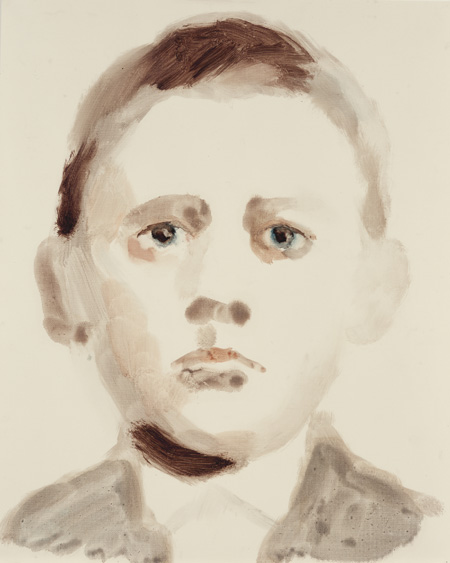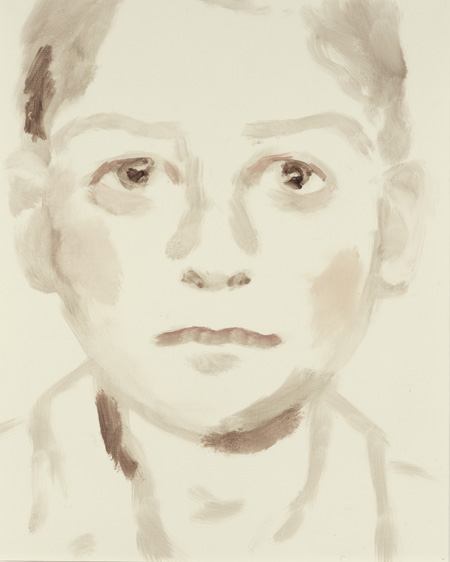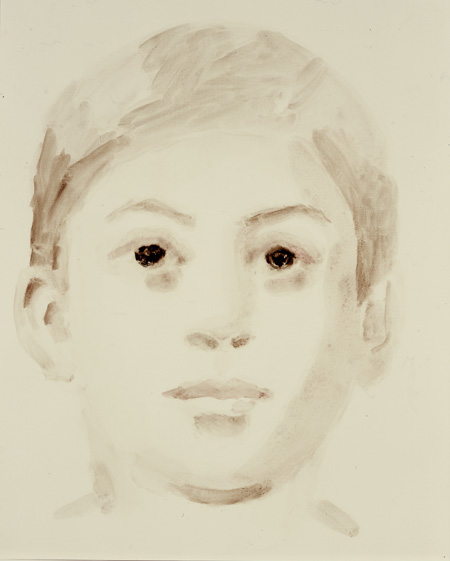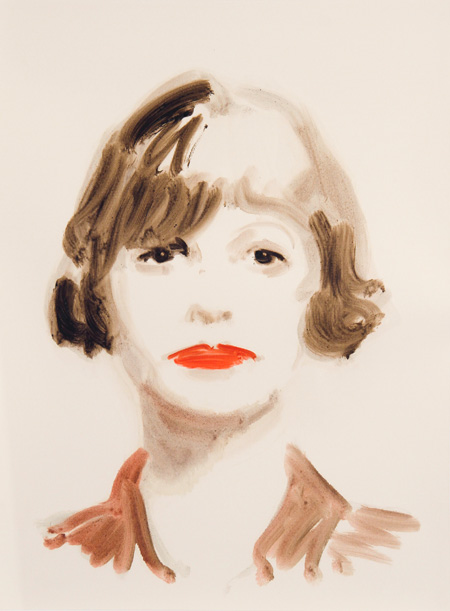The childish faces of Adolf Hitler and Joseph Stalin are amongst the evocative portraits of artist Annie Kevans’ work. Ahead of her group talk at the Saatchi Gallery, she tells Betty Wood why paper – her medium of choice – helps her achieve artistic honesty

Peering at the painted face of an infant Adolf Hitler, there’s a spark of innocence in the soft oily hues of his eyes. No hint is present of the unspeakable evil that this man – and the others included in the series – will perpetrate as an adult, confronting our understanding of ‘evil’; where does it start? It’s an uncomfortable discourse, one that challenges our political and social understanding of the world around us, and is just one of the provocative subject matters of English artist Annie Kevans’ work. Her series of oil paintings on paper entitled Boys features in the Saatchi Gallery’s group exhibition Paper; ahead of the artists in conversation talk on Thursday, Kevans tells Betty Wood about the importance of paper in achieving artistic honesty, and why intimacy is always present in her paintings.
You’ve a long established connection with the Saatchi Gallery, stretching back to your BA degree show Boys, which Charles Saatchi bought in full in 2004. Boys is being exhibited as part of group exhibition Paper – as an artist, how does it feel seeing your work revisited like this after such a long period?
The last time I saw the paintings, they were unframed and pinned to a scruffy college wall. It is great to see them again, nine years later, framed and spaced out in one long row around three walls of a beautiful gallery, subtly positioned at a low height. The series seems to be having a global appeal as the boys depicted have had such an impact on so many people’s lives around the world. To us the names are synonyms of evil but to millions of people they are very real and, sadly, still current sources of misery.
Paper’s exhibiting artists share a medium, but do you think it’s an incidental connection, or does it speak about a collective concern or interest?
The artists showing in Paper use the material in very different ways. As children, we all draw and paint on paper. As artists, many of us see it as a beautifully cheap and simple surface to work on. As long as art shops provide a steady supply of intriguing papers to work with, artists will use it.I first began working with the idea of painting ‘evil’ children (Adolf Hitler, Fred West, Mary I and Al Capone) on board, but I wasn’t happy with the results and considered using photography instead.
However, I soon realised it involved finding children to pose for the photos and, strangely, the work wouldn’t have had the same ring of truth about it as the paintings do i.e. I would have had to create photos that looked like genuine ones, and this would have seemed deliberately deceitful. I decided to return to painting (this time on canvas) and narrowed down the series to political leaders. The resulting group of canvases felt too heavy and colourful to work together and, eventually, I decided that the series worked best on oil-painting paper.The paper I discovered was gorgeous to paint on as it is oil-primed and repels and absorbs oil paint in equal measures. The paint glides on but sinks into it and spreads very delicately. Unfortunately, the manufacturers of the paper have stopped making it and I must find a new surface to paint on…
Painting gives me freedom to explore ideas in a way I found impossible to do with photography. It feels fresh and fast, like a fleeting thought. It lacks the gravitas and historical associations that canvas has. I am able to pull away from the formality of the painted portrait on canvas, but use the associations that people have with portraiture to my advantage. By that I mean people assume that portraiture has a certain truth embedded within it – we look at portraits and presume the person depicted really existed and that the likeness is real. This leads people to presume that my paintings are ‘real’, although many of my ‘portraits’ do not bear any resemblance to the person depicted. My work deals with concepts much more than it does with the likeness and accuracy of a ‘portrait’.

The ‘intimacy of paper’ is something that will be discussed at the talk; how does paper lend itself creating intimacy when you’re working in addition to freedom?
Immediacy creates intimacy. We love to see the brush or pencil marks made by an artist and regognise the direct link between the marks and the artist’s conscious or subconscious at a precise moment in time. There is a rawness about such work – it reveals a lot about your personality and opens you up to much more criticism than a photograph or installation ever could (photographs look polished and ‘professional’). You have to be brave to exhibit art, but especially brave to exhibit paintings and drawings. An hour before I first showed Boys, I panicked and thought “What the hell am I doing? I can’t show this to anyone!”. I felt exposed and vulnerable.
Recently, I was excited and moved by an exhibition of Leonardo da Vinci’s drawings. I loved seeing the pencil and chalk marks, and could imagine da Vinci sitting very still, drawing for hours, lost in his work. Most of us have experience of drawing and we can immediately put ourselves in his place and imagine ourselves trying to draw what he drew. When paper is used as a surface to work on, the artist’s hand is undeniably present. There is no chance of the work being made by an artist’s employee.
I like an artist’s DNA to be all over their work. We are all aware that some artists employ other artists to create their work for them and I simply don’t see the point in this, except to maximise profits. There is a massive disconnection by the artist from the work being produced in their name, which simply cannot occur with a unique work like a drawing or painting on paper.
How is this reflected thematically throughout your body of paintings, from Boys to present more recent collections like Collaborators?
With all of the themes I cover, I strive to reveal ‘the truth’ in some form or other. Sometimes the true likeness of a person depicted in my work is totally irrelevant as the truth of the concept is what matters. Often, I paint people from the past and nobody knows what that person looked like. I create an image of a believable person who can communicate something to the viewer of the work. I choose the people I paint based on what they represent to me and sometimes this can be at odds with how people normally think of that person.
Coco Chanel’s image has been reinvented to the point that it has nothing to do with who she really was – she was a well-known Nazi collaborator who had to flee France for 10 years after World War Two for fear of retribution by her own people. Today, this is persistently ignored in films and books about her and people happily walk about with her name proudly emblazoned on their person.

Does this intimacy facilitate the discussion of socially taboo subjects?
I like to think my work causes people to reflect on how they feel deep down about certain taboo subjects. You feel anxiety and relief at the same time when you are able to express your feelings about things. I think most of us learn to tolerate many things thrown at us, but many of us feel that we are treated like idiots who can’t handle the truth. There is also constant pressure to conform and not step out of line with our thoughts.
In the US, Thomas Jefferson is revered as a God and very few historians dare to discuss his ‘slave-keeping’ in depth. The Thomas Jefferson Memorial Foundation acknowledges that DNA tests prove that Jefferson likely fathered one, if not all six, of the children of his slave Sally Hemings, who was only 14 years old when he first started having sex with her (she herself was the half-sister of his wife).
When I visited Monticello, Jefferson’s plantation in Virginia, I was shocked to hear the guide’s description of the slaves as enjoying a good quality of life and being “better off than most white farmers”. Jefferson was described as being a fantastic master who gave his slaves “access to health care”. When I asked her about Sally Hemings, the patriotic plump white woman, wearing a USA-flag brooch, clenched her teeth and spat “we are the authority on Jefferson and we say that it is all lies”.

What is it about working on paper that continues to resonate with the public? And why, in spite of this fact, do educational art institutions in the UK increasingly push students towards studying more “contemporary” forms of art practice, like the video and sound installations and performance art?
People can connect with paper – there’s an understanding of the language of drawing and painting on paper and on other commonly-used surfaces. I think an important aspect of going to art school is to experiment with art forms and I imagine it must be frustrating for teachers to come across undergraduates who want to work mindlessly within their comfort zones of drawing, taking photographs and dabbling in painting and sculpture. Many of us go to art school with an idea of what we are good at when we haven’t even experimented with half of the art forms available to us.
I was fortunate to go to art school for 7 years on a part-time basis (2 on Foundation and 5 on the BA course). Although I was only at college one day a week, I was able to experiment with many different art forms and, by the time I came back to painting, I knew exactly why I was painting and why it was the medium for me. Being challenged to explain my thoughts and ideas was essential for me to evolve as an artist.
Paper: Ben Street, Annie Kevans, Dominic McGill and Paul Westcombe in Conversation takes place at 7.30pm 25th July at the Saatchi Gallery. For tickets and further information click here




